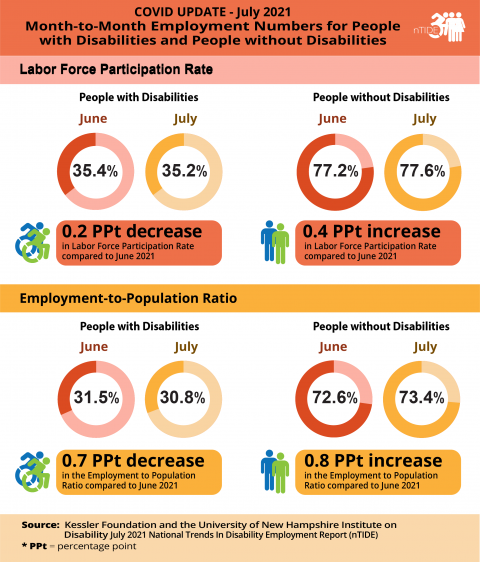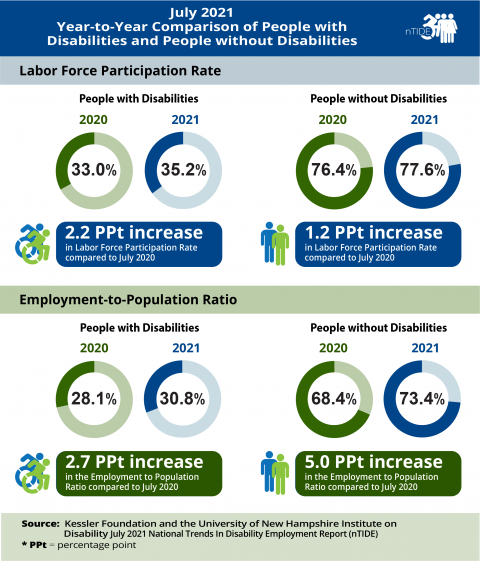
Economic indicators flattened following the sharp rises seen in June, with minor declines for people with disabilities and slight increases for people without disabilities, according to today’s National Trends in Disability Employment. Guest speaker John Robinson, CEO of Our Ability.
nTIDE July 2021 Jobs Report: Employment slows as COVID pandemic restrictions loom
National Trends in Disability Employment (nTIDE) – issued semi-monthly by Kessler Foundation and the University of New Hampshire
Durham, NH – August 6, 2021: Economic indicators flattened following the sharp rises seen in June, with minor declines for people with disabilities and slight increases for people without disabilities, according to today’s National Trends in Disability Employment – Monthly Update (nTIDE), issued by Kessler Foundation and the University of New Hampshire’s Institute on Disability (UNH-IOD). If the spread of the COVID-19 Delta variant causes the reinstatement of restrictions on business activity, a chilling effect is likely on upcoming job numbers.
nTIDE COVID Update (month-to-month comparison)

In the Bureau of Labor Statistics (BLS) Jobs Report released Friday, the employment-to-population ratio for working-age people with disabilities decreased from 31.5 percent in June to 30.8 percent in July 2021 (down 2.2 percent or 0.7 percentage points). For working-age people without disabilities, the employment-to-population ratio increased from 72.6 percent in June to 73.4 percent in July 2021 (up 1.1 percent or 0.8 percentage points). The employment-to-population ratio, a key indicator, reflects the percentage of people who are working relative to the total population (the number of people working divided by the number of people in the total population multiplied by 100).
“We saw minor declines in the employment-to-population ratio for those with disabilities,” said John O’Neill, PhD, director of the Center for Employment and Disability Research at Kessler Foundation. “This trend may continue if mass vaccination efforts fail to gain control over the COVID-19 Delta variant outbreaks,” he added.
The labor force participation rate for working-age people with disabilities decreased from 35.4 percent in June to 35.2 percent in July 2021 (down 0.6 percent or 0.2 percentage points). For working-age people without disabilities, the labor force participation rate also increased from 77.2 percent in June to 77.6 percent in July 2021 (up 0.5 percent or 0.4 percentage points). The labor force participation rate is the percentage of the population that is working, not working and on temporary layoff, or not working and actively looking for work.
“The labor force participation of people with disabilities has remained strong throughout the Pandemic. This small month-to-month decline is coming off our largest month-to-month increase,” said economist Andrew Houtenville, PhD, research director of the University of New Hampshire’s Institute on Disability. “I would expect people with disabilities to remain in the labor force (working, looking for work, or on furlough), as they have throughout the Pandemic, even as the Delta variant spreads, and social distancing requirements are reinstated.” he added.
Year-to-Year nTIDE Numbers (comparison to the same time last year)

The employment-to-population ratio for working-age people with disabilities increased from 28.1 percent in July 2020 to 30.8 percent in July 2021 (up 9.6 percent or 2.7 percentage points). For working-age people without disabilities, the employment-to-population ratio also increased from 68.4 percent in July 2020 to 73.4 percent in July 2021 (up 7.3 percent or 5 percentage points).
The labor force participation rate for working-age people with disabilities increased from 33 percent in July 2020 to 35.2 percent in July 2021 (up 6.7 percent or 2.2 percentage points). For working-age people without disabilities, the labor force participation rate also increased from 76.4 percent in July 2020 to 77.6 percent in July 2021 (up 1.6 percent or 1.2 percentage points).
In July 2021, among workers ages 16-64, the 4,912,000 workers with disabilities represented 3.4 percent of the total 143,835,000 workers in the U.S.
Ask Questions about Disability and Employment
Join our nTIDE Lunch & Learn series today, August 6, at 12:00 pm Eastern. This live broadcast, hosted via Zoom Webinar, offers attendees Q&A on the latest nTIDE findings, provides news and updates from the field, as well as invited panelists to discuss current disability-related findings and events. Today, John Robinson, CEO of Our Ability, joins Drs. Houtenville and O’Neill, and Denise Rozell, Policy Strategist at AUCD. Join live or watch the recordings at: ResearchonDisability.org/nTIDE.
nTIDE COVID Update – Friday, August 20 at 12:00 pm Eastern
Stay tuned for our mid-month update about the employment of people with disabilities as we follow the impact of COVID-19 and look at the numbers in more detail.
